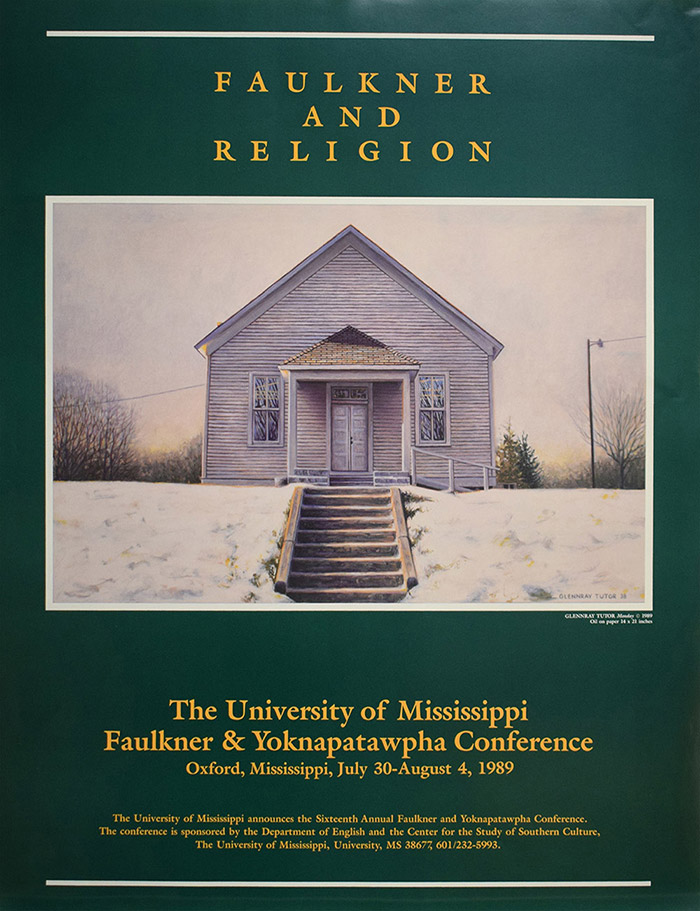
The Crucifixion in Light in August
Location
Education Auditorium
Start Date
4-8-1989 9:00 AM
Description
Recognizing Light in August's peculiar blend of religion and myth, Lawrance Thompson believed that Faulkner was "contrasting certain pagan attitudes with certain Christian attitudes for the purposes of honoring the pagan." But an examination of chapter nineteen suggests a far more complicated intent.
The peculiar blend originates in Faulkner's use of Modernist writing techniques. Paralleling his 21 chapters with the 21 chapters of the St. John gospel, Faulkner expanded on the biblical tales with related material from James Frazer's unabridged Golden Bough. For example, reflecting John seven's teaching in the temple, Faulkner's seven presents McEachern trying to teach Joe his catechism in the stable. But Faulkner also reflects Frazer's accounts of initiation rites, where boys would be kept in holy enclosures and beaten; they would fall and lie trance-like until sacred food was brought to be eaten, often without hands. Thus, Faulkner's chapter begins: On this day I became a man, and during that day Joe is kept in the stable or his room; he is beaten; he lies trance-like; and when he finally eats, it is on the floor "like a savage, like a dog."
In nineteen, besides reflecting specifics from the crucifixion chapter, Faulkner has seized on John's ubiquitous motif of the "post," relating it to the timing of the Passover, to the sacrifice of redeemers or mock kings, and to the most dramatic blood-on-the-post, the ancient castrating--and castrated—Priests of the Galli. In the figure of the executioner, Percy, whose name means both "destroyer" and "pansy," Faulkner suggests the inexorability of blood when manhood is given over and authority is suspended. His message is that the good people of this earth will ever have the potential for savagery. Religion not only cannot save us from this savagery; religion—Christian or pagan—can be the cause of it.
Relational Format
Conference Proceeding
Recommended Citation
Hlavsa, Virginia V., "The Crucifixion in Light in August" (1989). Faulkner and Yoknapatawpha Conference. 25.
https://egrove.olemiss.edu/fy/1989/schedule/25
The Crucifixion in Light in August
Education Auditorium
Recognizing Light in August's peculiar blend of religion and myth, Lawrance Thompson believed that Faulkner was "contrasting certain pagan attitudes with certain Christian attitudes for the purposes of honoring the pagan." But an examination of chapter nineteen suggests a far more complicated intent.
The peculiar blend originates in Faulkner's use of Modernist writing techniques. Paralleling his 21 chapters with the 21 chapters of the St. John gospel, Faulkner expanded on the biblical tales with related material from James Frazer's unabridged Golden Bough. For example, reflecting John seven's teaching in the temple, Faulkner's seven presents McEachern trying to teach Joe his catechism in the stable. But Faulkner also reflects Frazer's accounts of initiation rites, where boys would be kept in holy enclosures and beaten; they would fall and lie trance-like until sacred food was brought to be eaten, often without hands. Thus, Faulkner's chapter begins: On this day I became a man, and during that day Joe is kept in the stable or his room; he is beaten; he lies trance-like; and when he finally eats, it is on the floor "like a savage, like a dog."
In nineteen, besides reflecting specifics from the crucifixion chapter, Faulkner has seized on John's ubiquitous motif of the "post," relating it to the timing of the Passover, to the sacrifice of redeemers or mock kings, and to the most dramatic blood-on-the-post, the ancient castrating--and castrated—Priests of the Galli. In the figure of the executioner, Percy, whose name means both "destroyer" and "pansy," Faulkner suggests the inexorability of blood when manhood is given over and authority is suspended. His message is that the good people of this earth will ever have the potential for savagery. Religion not only cannot save us from this savagery; religion—Christian or pagan—can be the cause of it.

